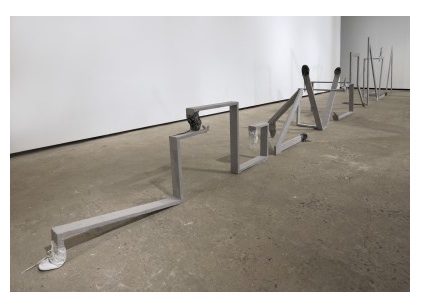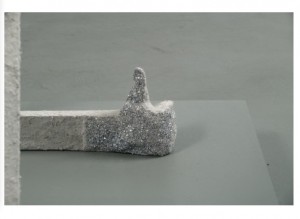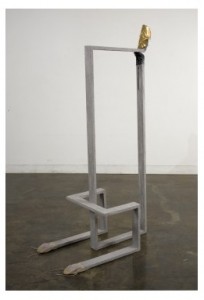Jennifer Cohen at Salon 94
JENNIFER COHEN at Salon 94
Apparently, ballet originated as a dance interpretation of fencing. And Jennifer Cohen’s clever merging of ballet imagery (she has a background in dance) and sculptural tropes is indeed a series of feints and parries. At first glance, this body of work seems simply to valorize and memorialize, with “souvenirs” such as ballet slippers as lovingly preserved as bronzed baby shoes. Or, more ambitiously, it seems to attempt to capture motion: the long thin abridgments which travel through the space, horizontal, vertical, bent—ending in a foot or delicately drooping hand—might be a variety of labanotation, one of several “languages” invented to preserve in shorthand the choreography that is otherwise stored only in human memory. Those planks are obvious “limbs” but they may also be the barre, the warm-up rail so ubiquitous and necessary for a dancer that it can come to feel like a prosthesis. Some of the arrangements of these two-by-fours are as contorted as Pilobolus tableaux.
Yet this is no straightforward valediction after all. The long horizontal of a glissade here or a vertical elevee there, in between a break in continuity suggestive of a grand jete, can as easily illustrate failure: they enact a sort of domino effect, one gravity-induced collapse after another, a series of “if-then” collisions. And gravity, of course, is the enemy of dance. Then there is the royal patronage associated with this art form, perhaps slyly alluded to in the gilded surfaces of parts of the sculptures. But Cohen punctuates the flow of her installation, literally, with rude thumbing gestures, and the “silver” and “gold” is dulled out to an overall lead gray. Finally, the perennial objection to classical ballet—that it is as unnatural as foot binding—finds expression in the hard-bittened and flattened shoes.

Which brings us to the parry. There are so many art allusions here that have nothing to do with ballet, starting with the shoes. From Van Gogh’s Heidegger-enshrined boots to Rona Pondick’s ball of high heels to Robert Gober’s single, sinister child’s sandal, the shoe in art has left a Friday print in the sand perennially re-discovered by artist Crusoes. It seems to be able to address everything from existence itself to gender and perversion. Cohen’s shoes are “on pointe” for all these topics. Likewise the conflation of lumber with limb is everywhere in sculpture. Joel Shapiro’s metal stick figures come to mind, but also Barbara Zucker’s elongated legs on anthropomorphized Adirondack chairs, Jon Kessler’s mechanized foot on a yardstick, and Georg Herold’s lumberyard men and women, his boxing-gloved arms. In all this there is more than a hint of satire and the same is true of Cohen’s effigies. It may be in fact that Cohen is operating around a pun about the “hollow leg” of both art forms, about neither “having a leg to stand on.” Dance, it seems, is a rather slapstick affair after all, a bid for transcendence, a resistance to limits that must eventually end in defeat. Sculpture is shown to be just as contingent—not so much immortal bronze and no real silver but wood and celluclay, a kind of papier mache—theatrically “fake.”
There is a fine facility in the way Cohen takes charge of the exhibition space, using her sculptural dots and dashes to move us fluidly through it, much as we move through a sentence, thus adding a temporal experience to the spatial one. This feels like a homage to Anthony Caro’s innovative linear metal works which challenged a holistic comprehension of sculpture by insisting on an extended, time-based one, forcing a beginning, middle, and end on the viewer. Still, one feels a certain intelligent and affectionate skepticism in Cohen’s skill—as if she cannot bring herself to fully buy in to either of her areas of expertise—she knows too much, Nor, it seems, is she willing to reject them entirely. Instead, she keeps moving—she thrusts, she parries. It’s a dance; it’s a fight. She is warily “engage.” She says to herself, ”Feet, don’t fail me now.”
Ephraim Birnbnaum







